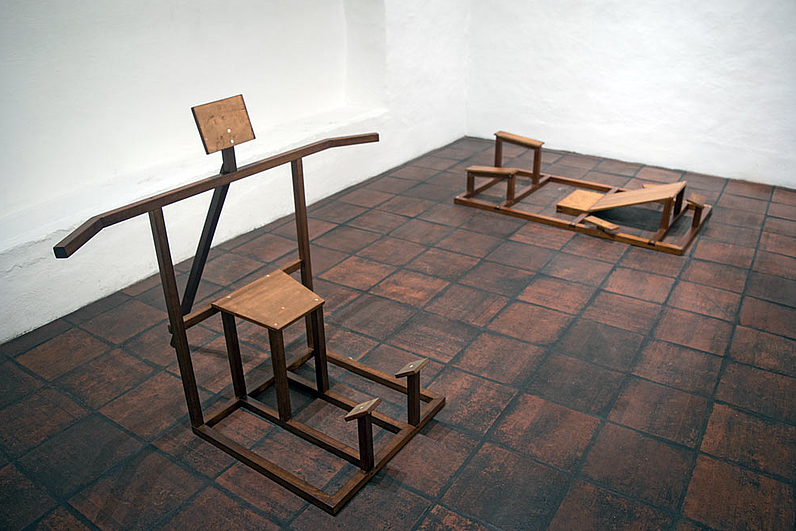Editor’s note: Nominated as a Future Great in 2017, Ana Mazzei is currently showing as part of the 14th Bienal de Cuenca: Living Structures. Art as a plural experience in Ecuador, on through 3 February. In 2018, Mazzei received two solo exhibitions at La Galerie centre d’art contemporain de Noisy-le-Sec, France and MAM Museu de Arte Moderna de São Paulo.
In the first months of 2015, visitors to Pivô – a non-profit space located at the iconic Copan building in downtown São Paulo – were greeted by an unusual presence. The reception desk had been placed on top of a high wooden platform, so that, upon entering the lobby, members of the public had to look up in order to communicate with the gallery’s employee. On the back of the structure, a golden disc attached to a metal bar framed her head like a halo, giving her a goddess-like appearance. Placed on the floor facing the desk stood a tall wooden prop representing a rock. The Monolith and the Sentinel, as many of Mazzei’s projects, had a theatrical quality, with objects arranged as props for some kind of unknown ritualistic ceremony, and encompassing the viewer as performer. To the challenge of occupying what is originally a place of passage at Pivô, the artist responded with a work that effectively shifted the way in which our bodies behave in this specific space.
The relationship between body and space is, in fact, central to Mazzei’s practice. Garabandal (2015), resembles a piece of furniture built in iron and fabric where the seat, armrests and knee pads were specifically designed to place the sitter’s body in what the artist describes as a position of ecstasy: face up, arms outstretched and knees bent. The title of the piece refers to the Spanish village that became famous during the 1960s when four local schoolgirls claimed to have witnessed the apparition of the Virgin Mary on several occasions, each time falling on their knees in a trance with their heads tilted back and eyes looking up. However, the religious subtext seems less important than the idea of performing bodies and the attempt to project a parallel reality that depends on a certain viewpoint or “building a scene that is quickly dissolved”, as Mazzei puts it.
Other works operate in a smaller scale, such as her series of floor installations formed by groups of small geometric works in felt, concrete or wood that resemble architectural models of ancient cities, amphitheatres, or monuments. Far from being formalist exercises, these floor works seem imbued with some unidentified narrative composed by mysterious archetypal shapes. This double movement of simultaneously suggesting and holding back the symbolic value of form is a recurring feature of her practice. Clearly staged, Mazzei’s own ‘theatre of the absurd’ creates fleeting realities that momentarily disturb our conditioned relationship to objects around us.
This article was first published in the January & February 2016 issue of ArtReview.
